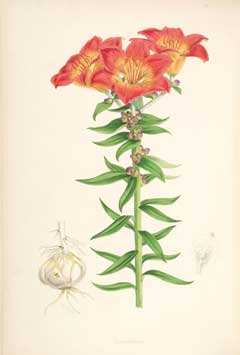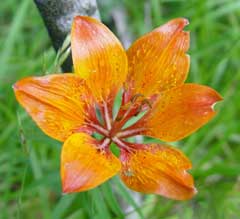 |
|
http://commons.wikimedia.org/wiki/File:Lilium_bulbiferum_%28lit%29.jpg |
 |
| http://www.the-genus-lilium.com/bulbiferum.htm |
Translate this page:
Summary
Physical Characteristics

 Lilium bulbiferum is a BULB growing to 1.2 m (4ft).
Lilium bulbiferum is a BULB growing to 1.2 m (4ft).
See above for USDA hardiness. It is hardy to UK zone 7. It is in flower from June to July, and the seeds ripen from August to September. The species is hermaphrodite (has both male and female organs) and is pollinated by Bees.
Suitable for: light (sandy), medium (loamy) and heavy (clay) soils and prefers well-drained soil. Suitable pH: mildly acid, neutral and basic (mildly alkaline) soils. It can grow in semi-shade (light woodland) or no shade. It prefers moist soil.
UK Hardiness Map
US Hardiness Map
Synonyms
L. croceum.
Plant Habitats
Woodland Garden Sunny Edge; Dappled Shade;
Edible Uses
Edible Parts: Root
Edible Uses:
Bulb - cooked. Sweet and mealy[177], they make very fair eating and can be used as a potato substitute[2].
References More on Edible Uses
Medicinal Uses
Plants For A Future can not take any responsibility for any adverse effects from the use of plants. Always seek advice from a professional before using a plant medicinally.
None known
References More on Medicinal Uses
The Bookshop: Edible Plant Books
Our Latest books on Perennial Plants For Food Forests and Permaculture Gardens in paperback or digital formats.

Edible Tropical Plants
Food Forest Plants for Hotter Conditions: 250+ Plants For Tropical Food Forests & Permaculture Gardens.
More

Edible Temperate Plants
Plants for Your Food Forest: 500 Plants for Temperate Food Forests & Permaculture Gardens.
More

More Books
PFAF have eight books available in paperback and digital formats. Browse the shop for more information.
Shop Now
Other Uses
References More on Other Uses
Cultivation details
Prefers an open free-draining humus-rich loamy soil with its roots in the shade and its head in the sun[200]. Succeeds in ordinary garden soil[1, 143] and in calcareous soils[90, 200]. Prefers summer shade[200]. Stem rooting, the bulbs should be planted 15cm deep[43, 143, 200]. Early to mid autumn is the best time to plant out the bulbs in cool temperate areas, in warmer areas they can be planted out as late as late autumn[200]. This is one of the easiest lilies to grow[47], it is cultivated for its edible bulb in Japan[2]. The plant should be protected against slugs in early spring. If the shoot tip is eaten out the bulb will not grow in that year and will lose vigour[200]. The typical form of this species forms bulbils on its stems[200]. The sub-species L. bulbiferum croceum does not normally produce bulbils[188].
References Carbon Farming Information and Carbon Sequestration Information
Temperature Converter
Type a value in the Celsius field to convert the value to Fahrenheit:
Fahrenheit:
The PFAF Bookshop
Plants For A Future have a number of books available in paperback and digital form. Book titles include Edible Plants, Edible Perennials, Edible Trees,Edible Shrubs, Woodland Gardening, and Temperate Food Forest Plants. Our new book is Food Forest Plants For Hotter Conditions (Tropical and Sub-Tropical).
Shop Now
Plant Propagation
Seed - delayed hypogeal germination[130]. Best sown as soon as ripe in a cold frame, it should germinate in spring[143]. Stored seed will require a warm/cold/warm cycle of stratification, each period being about 2 months long[163]. Grow on in cool shady conditions. Great care should be taken in pricking out the young seedlings, many people leave them in the seed pot until they die down at the end of their second years growth. This necessitates sowing the seed thinly and using a reasonably fertile sowing medium. The plants will also require regular feeding when in growth. Divide the young bulbs when they are dormant, putting 2 - 3 in each pot, and grow them on for at least another year before planting them out into their permanent positions when the plants are dormant[K]. Division with care in the autumn once the leaves have died down. Replant immediately[200]. Bulbils - gather in late summer when they start to fall off the stems and pot up immediately. Grow on in a greenhouse until large enough to go outside[163]. Bulb scales can be removed from the bulbs in early autumn. If they are kept in a warm dark place in a bag of moist peat, they will produce bulblets. These bulblets can be potted up and grown on in the greenhouse until they are large enough to plant out[200].
Other Names
If available other names are mentioned here
Native Range
EUROPE: Czechoslovakia, Austria, Switzerland, Germany, Hungary, Poland, Former Yugoslavia, Italy, Spain, France (incl. Corsica)
Weed Potential
Right plant wrong place. We are currently updating this section.
Please note that a plant may be invasive in one area but may not in your area so it's worth checking.
Conservation Status
IUCN Red List of Threatened Plants Status :

Growth: S = slow M = medium F = fast. Soil: L = light (sandy) M = medium H = heavy (clay). pH: A = acid N = neutral B = basic (alkaline). Shade: F = full shade S = semi-shade N = no shade. Moisture: D = dry M = Moist We = wet Wa = water.
Now available:
Food Forest Plants for Mediterranean Conditions
350+ Perennial Plants For Mediterranean and Drier Food Forests and Permaculture Gardens.
[Paperback and eBook]
This is the third in Plants For A Future's series of plant guides for food forests tailored to
specific climate zones. Following volumes on temperate and tropical ecosystems, this book focuses
on species suited to Mediterranean conditions—regions with hot, dry summers and cool, wet winters,
often facing the added challenge of climate change.
Read More
Expert comment
Author
L.
Botanical References
200
Links / References
For a list of references used on this page please go here
Readers comment
| Add a comment |
|
If you have important information about this plant that may help other users please add a comment or link below. Only comments or links that are felt to be directly relevant to a plant will be included. If you think a comment/link or information contained on this page is inaccurate or misleading we would welcome your feedback at [email protected]. If you have questions about a plant please use the Forum on this website as we do not have the resources to answer questions ourselves.
* Please note: the comments by website users are not necessarily those held by PFAF and may give misleading or inaccurate information.
To leave a comment please Register or login here All comments need to be approved so will not appear immediately.
|
Subject : Lilium bulbiferum
|
|
|
|